Neuengamme Concentration Camp
Photos of Memorial Site by Bonnie
M. Harris
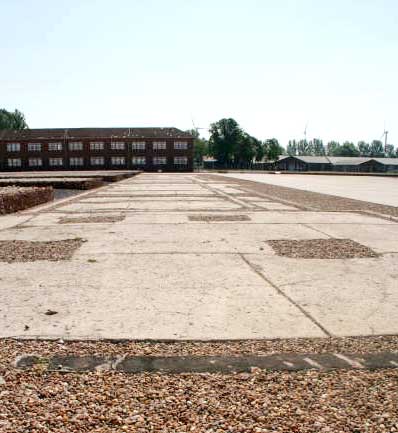
Reconstructed parade
ground where roll call was taken
Photo Credit: Bonnie
M. Harris
A fragment of the historic parade ground,
around 800 square meters in size, was discovered when a prison
building, erected after the war, was demolished in 2003. This
fragment was integrated into a reconstruction of the parade ground.
The broken lines that you see in the photo above are parts of
the concrete foundations of a cell block for the Vierlande Correction
Center, which was erected on this section of the parade ground
in 1949/50. Together with the remains of the prison building
to the north, they document the post-war use of the concentration
camp.
The Memorial Site has information in
four languages, including English, at each of the places of interest
in the former camp, as shown in the photo below.
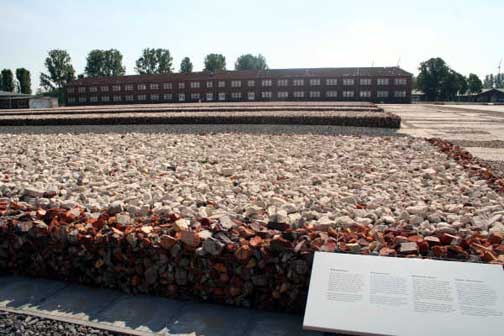 Former location of
barracks with parade ground on the right
Photo Credit: Bonnie
M. Harris
Former location of
barracks with parade ground on the right
Photo Credit: Bonnie
M. Harris
According to information given at the
Memorial Site, in mid-October 1941, a transport of 1,000 Soviet
POWs from Stalag X D Wietzendorf arrived in Neuengamme. They
were made to sleep crammed together on the floors of Blocks 7
and 14, which were fenced off and designated as "the labor
camp for prisoners of war." The POWs were given especially
bad food. This sparked a solidarity campaign among the other
prisoners at Neuengamme and many shared their bread with them.
By mid-1942, the 348 POWs who were still alive were then transferred
to the Sachsenhausen concentration camp. Their fate thereafter
is unknown.
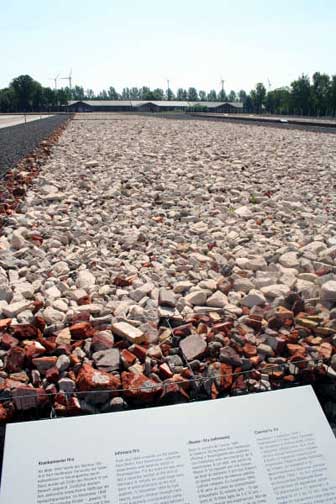 Location of Infirmary
where medical experiments were conducted
Photo Credit: Bonnie
M. Harris
Location of Infirmary
where medical experiments were conducted
Photo Credit: Bonnie
M. Harris
The following information about medical
experiments at Neuengamme is from the Memorial Site:
From mid-1944 onwards, an SS doctor
from Berlin, Kurt Heissmeyer, undertook experiments with tubercle
bacilli in Neuengamme. For his trials, he was allotted a separate
section at the end of Infirmary IV. Initially, he used large
numbers of adult prisoners as his test patients. In November
1944, he had twenty Jewish children brought here from Auschwitz
concentration camp - ten boys and ten girls aged between 5 and
12 - with whom he continued his experiments. On 20 April 1945,
in an attempt to erase all traces of these crimes, SS soldiers
murdered the children at the Bullenhuser Damm satellite camp.
The experiments done by Kurt Heissmeyer,
in which around 200 subjects died, were designed to disprove
the theory that tuberculosis was purely an infectious disease.
Heissmeyer maintained that only unhealthy people and especially
"racially weak and inferior persons, such as the Jews,"
were susceptible to tuberculosis. Heissmeyer attempted to determine
whether there was any natural immunity to tuberculosis and to
develop a vaccine against the disease.
Heissmeyer removed the lymph glands from
the 20 Jewish children as part of his experiment. As the British
Army approached the camp in April 1945, the children were transferred
to the Bullenhuser Damm satellite camp, where they were murdered
by hanging from hooks, according to the US Holocaust Museum.
After the war, Heissmeyer had a medical
practice for 18 years in Magdeburg in East Germany where he was
a well-respected lung and tuberculosis specialist. He was not
selected for the Doctor's Trial at Nuremberg where 23 physicians
were tried, including several who had conducted medical experiments
in the concentration camps. In the British war crimes trial for
the Neuengamme staff, held in 1946 in Hamburg, SS doctors Bruno
Kitt and Alfred Trzebinski were convicted and subsequently hanged,
but Dr. Heissmeyer was not among the accused. Eventually, Heissmeyer
was tried by a German court in 1966 and sentenced to life in
prison; he died in prison 14 months later.
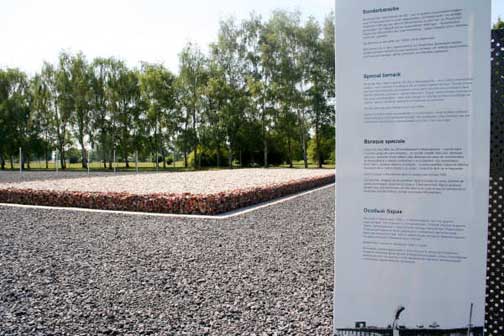 Location of the Special
Barrack, used as a brothel for the prisoners
Photo Credit: Bonnie
M. Harris
Location of the Special
Barrack, used as a brothel for the prisoners
Photo Credit: Bonnie
M. Harris
The following information about the "Special
barrack" is from the Memorial Site:
From late May 1944 onwards, the SS
in Neuengamme - as in other concentration camps - ran a brothel
in a fenced-off, so-called 'special barrack'. Female prisoners
from Ravensbrück concentration camp were coerced into prostitution
here. Certain selected prisoners - skilled laborers, 'capos'
and prisoners working for the camp administration - were also
allowed to visit the brothel in exchange for special 'bonus vouchers'
awarded as incentives to prisoners.
The barrack was demolished in the
mid-1950s.
Women forced to work as prostitutes
in concentration camp brothels suffered severe physical and emotional
damage. The persecution they endured was not researched and publicly
acknowledged until just a few years ago.
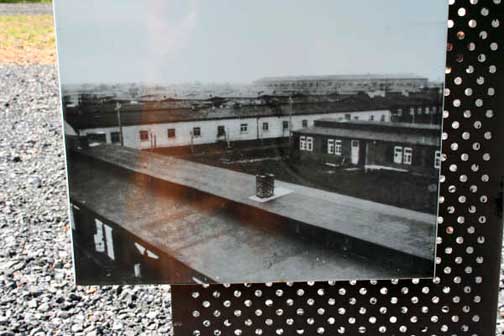 Photo of separate camp
for French "special prisoners"
Photo Credit: Bonnie
M. Harris
Photo of separate camp
for French "special prisoners"
Photo Credit: Bonnie
M. Harris
According to the Memorial Site, a camp
for French "special prisoners" existed from October
1944 onwards. Two fenced-off horse barns of the type used for
barracks were converted into a special camp for some 400 French
inmates who had been brought to Neuengamme concentration camp
in July 1944. The two dark-colored buildings in the photo above
were the "stables" used as barracks in the French camp.
High-ranking politicians, church dignitaries and other figures
of public life were accorded a privileged status and quartered
here, some of them also with their families. They were allowed
to keep their own clothes and belongings, were relieved from
performing forced labour and granted somewhat better living conditions
than the other camp prisoners.
|